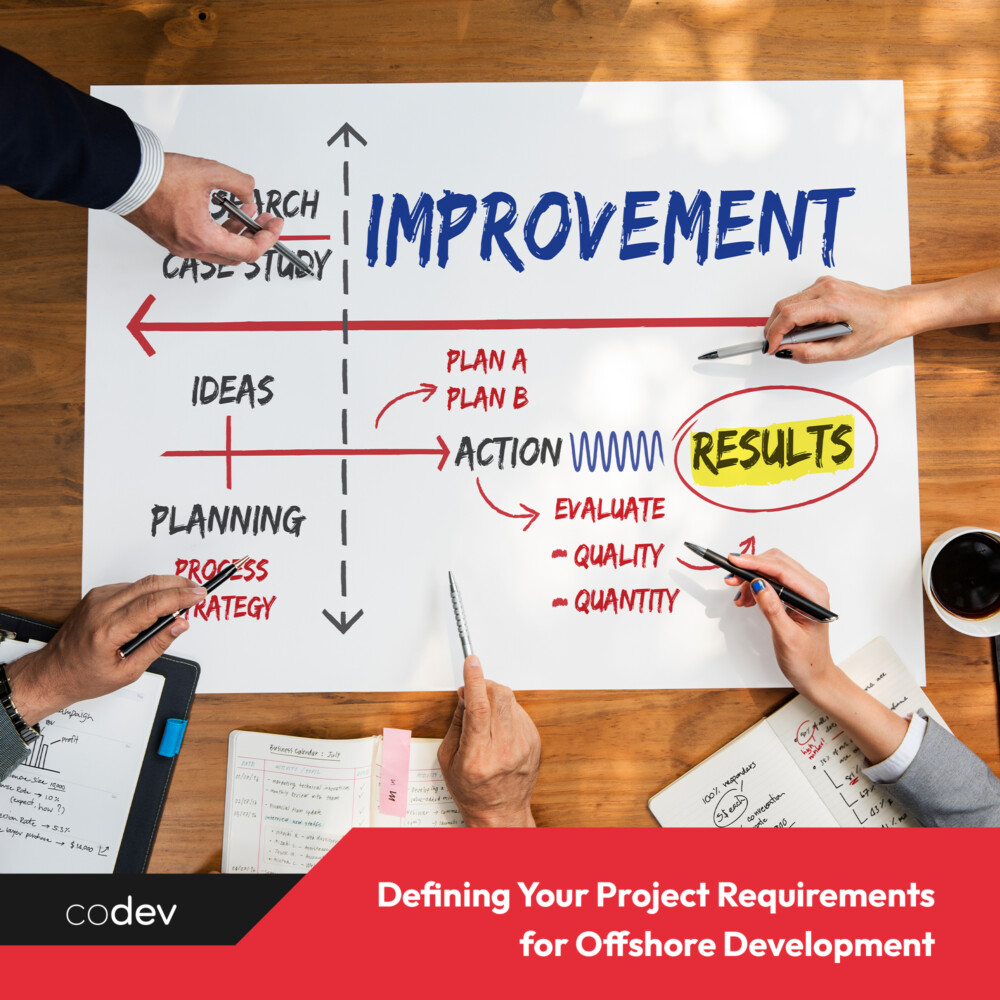Defining Your Software Project Requirements for Offshore Development

When embarking on a transformative offshore development journey, the key to unlocking success lies in laying a solid foundation for your product. Understanding your software requirements is paramount to ensure a streamlined development phase and triumphant collaboration with an offshore development team.
In this comprehensive guide, we will navigate you through the essential steps to define your project, create software requirements specification documents, and set your software development project on the path to completion.
Create a Software Requirements Specification Document (SRS)
A Software Requirements Specification is a vital document that summarizes your project and its components. It includes the project's main purpose, scope, personas, user needs, and other necessary definitions. This document serves as the cornerstone of your project, providing a clear roadmap for your project team and aligning everyone involved toward the same goals.
The SRS outlines the main purpose and scope of the project, identifies user personas, and lays down the necessary definitions. It serves as a powerful communication tool, ensuring that your vision is accurately understood by your offshore team and stakeholders.
Define the Project's Purpose
Defining the project's purpose provides clarity on why the product is being developed and what problem it aims to solve. Clearly articulating the purpose ensures that all stakeholders are aligned and focused on the core objectives and the product scope.
Consider the following aspects when defining the project purpose:
- Problem Statement: Clearly state the problem or challenge that the product aims to address. Understanding the problem will guide developers in crafting relevant and effective solutions.
- Project Goals and Objectives: Outline the specific goals and objectives the software product should achieve. These goals will serve as the foundation for creating concrete project requirements.
- Value Proposition: Define the unique value that the software product will offer to its users. Articulate how the product will stand out and provide a competitive advantage.
- Success Criteria: Establish measurable success criteria to determine the project's success. These criteria will serve as benchmarks to evaluate the project's achievements.
Conduct a Feasibility Study
A feasibility study evaluates the project's technical, economic, legal, operational, and scheduling aspects to determine if the proposed software user interface development project is feasible and worth pursuing. This study provides insights into potential risks, constraints, and challenges that may impact the software interfaces project's success.
During the software engineering and development process of the feasibility study, consider the following key factors:
- Technical Feasibility: Assess the project's technical requirements, including the technology stack, infrastructure, and software development tools.
- Economic Feasibility: Analyze the project's cost-benefit analysis, budget constraints, and potential return on investment.
- Legal Feasibility: Examine legal and regulatory factors that may affect the development of the software. Check for data protection laws, copyright, and intellectual property considerations.
- Operational Feasibility: Evaluate how the proposed software will integrate into existing systems and processes.
- Scheduling Feasibility: Create a realistic project timeline, taking into account potential delays, resource availability, and dependencies.
Determine the Audience
Understanding who will be using your product allows you to tailor the software requirements to your intended audience to meet their specific needs and preferences.
Work with your team to develop personas and identify key characteristics of your target audience. This step will provide valuable insights that will shape the direction of your project.
Make a List of Stakeholders and Discuss the Project with Them
Identifying the stakeholders is crucial for the success of your offshore development project. Stakeholders may include clients, customers, end-users, organizational leaders, and other key players. Engage in discussions with these stakeholders to gather their input and understand their expectations.
While not all suggestions may be feasible, as a team leader or software developer, you can provide advice on how to best incorporate their requirements into the project's overall description and scope.
Work with the Development Team and Other Critical Players
Collaborate closely with your team, QA analysts, project managers, and other essential team members. Their expertise will provide valuable insights into how the system features functional requirements contribute to the project's success. This collaboration ensures that the project moves forward smoothly and efficiently.
Categorize Requirements for the Software Development Process
Organize the software project requirements into categories to maintain clarity and organization. The main categories are functional and non-functional requirements, but you can further expand them to cover technical, business, and security aspects with minimum hardware requirements. Categorization of software requirement specifications will help you keep track of various objectives and facilitate better communication within your team.
Keep Things Simple
While your software project may be complex, it is crucial to keep the functional requirements clear and straightforward. The documentation maintains that you need to put in as much detail as possible but complexity in requirements may lead to misunderstandings and hinder progress. The software requirement specification document should keep everyone on the same page.
Simplicity in software requirements allows your offshore team to focus on meeting the goals efficiently while having the flexibility to explore innovative approaches.
Draw a Connection Between Each Requirement and the Purpose of the Software
Every requirement should align with the main purpose and mission of the software. Each functional requirement should directly contribute and the desired system for the satisfaction of clients and end-users. Ensuring this alignment will guarantee that the software development process you are pursuing is still on track to deliver what it promises.
Use Clear, Precise Language
Unambiguous language is essential in the software requirements specification document. Precise language reduces the risk of confusion or misinterpretation of your user interface requirements and provides a clear direction for your offshore team. Be specific in explaining the "who, what, when, where, and why" of each requirement.
Track Software Project Requirements
Keeping meticulous track of all requirements is essential when developing software to ensure their successful completion. Utilize project management tools to manage requirements, set deadlines, and monitor progress. This visual approach helps everyone involved understand their roles and responsibilities throughout the development process and that all listed in the software requirements specification are attained within the timeline.
Document All Changes
As the software development process evolves, requirements may change over time as users expand in demand and diversity. It is essential to document all modifications to software requirements specifications, maintain transparency, and create a record of the project's iterations.
At times, updated software requirements specifications may need to be published to keep the team updated on all the changes.
Conclusion
Knowing the requirements of your software is a critical step in the offshore development process. Following these steps will empower you to successfully tackle projects of varying complexity. Clear and well-defined software requirements specifications will set a clear path for your team, leading to a more straightforward and successful collaboration.
At Codev, we understand the significance and can help you streamline your offshore development journey. Partner with us today and bring your software vision to life.
Are you in search of the perfect talents to join your company's ranks? Look no further! We specialize in connecting businesses with exceptional professionals who will help drive your success to new heights. Don't miss the opportunity to take your team to the next level!




